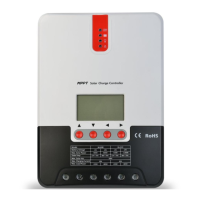07 08
Warning: risk of explosion! Never install the
controller and an open battery in the same enclosed
space! Nor shall the controller be installed in an enclosed
space where battery gas may accumulate.
Warning: danger of high voltage! Photovoltaic arrays
may produce a very high open-circuit voltage. Open the
breaker or fuse before wiring, and be very careful during
the wiring process.
!
Note: when installing the controller, make sure that
enough air flows through the controller's radiator, and
leave at least 150 mm of space both above and below the
controller so as to ensure natural convection for heat
dissipation. If the controller is installed in an enclosed box,
make sure the box delivers reliable heat dissipation effect.
≥150mm
≥150mm
• Be very careful when installing the battery. For open lead-acid batteries, wear a pair of goggles during installation,
and in case of contact with battery acid, flush with water immediately.
• In order to prevent the battery from being short-circuited, no metal objects shall be placed near the battery.
• Acid gas may be generated during battery charging, thus make sure the ambient environment is well ventilated.
• Keep the battery away from fire sparks, as the battery may produce flammable gas.
• When installing the battery outdoors, take sufficient measures to keep the battery from direct sunlight and rain water
intrusion.
• Loose connections or corroded wire may cause excessive heat generation which may further melt the wire's insulation
ML2420
ML2430
20A
30A
20A
20A
5
5
mm
2
mm
2
5
6
mm
2
mm
2
ML2440
40A 20A
5
mm
2
10
mm
2
>Equalizing charging
Warning: risk of explosion!
In equalizing charging, an open lead-acid battery can produce explosive gas, therefore the battery chamber shall have
good ventilation conditions.
Note: risk of equipment damage!
Equalizing charging may raise the battery voltage to a level that may cause damage to sensitive DC loads. Check and
make sure that allowable input voltages of all the loads in the system are greater than the set value for battery
equalizing charging.
Note: risk of equipment damage!
Overcharge or too much gas generated may damage battery plates and cause active material on the battery plates to
scale off. Equalizing charging to an excessively high level or for too long a period may cause damage. Read carefully the
actual requirements of the battery deployed in the system.
Some types of batteries benefit from regular equalizing charging which can stir the electrolyte, balance the battery
voltage and finish the electrochemical reaction. Equalizing charging raises the battery voltage to a higher level than the
standard supply voltage and gasify the battery electrolyte. If the controller then automatically steers the battery into
equalizing charging, the charging duration is 120 mins (default). In order to avoid too much generated gas or battery
overheat, equalizing charging and boost charging won’t repeat in one complete charging cycle.
Note:
1) When due to the installation environment or working loads, the system can't continuously stabilize the battery
voltage to a constant level, the controller will initiate a timing process, and 3 hours after the battery voltage reaches the
set value, the system will automatically switch to equalizing charging.
2) If no calibration has been done to the controller clock, the controller will perform equalizing charging regularly
according to its internal clock.
!
!
>Floating charging
When finishing the sustaining charging stage, the controller will switch to floating charging in which the controller
lowers the battery voltage by diminishing the charging current and keeps the battery voltage at the set value of floating
charging voltage. In the floating charging process, very light charging is carried out for the battery to maintain it at full
state. At this stage, the loads can access almost all the solar power. If the loads consume more power than the solar
panel could provide, the controller will not be able to keep the battery voltage at the floating charging stage. When the
battery voltage drops to the set value for returning to boost charging, the system will exit floating charging and reenter
into fast charging.
2. Product Installation
2.1 Installation Precautions
layer and burn surrounding materials, and even cause a fire, therefore make sure all connections are tightened securely.
Wires had better be fixed properly with ties, and when needs arise to move things, avoid wire swaying so as to keep
connections from loosening.
• When connecting the system, the output terminal's voltage may exceed the top limit for human safety. If operation
needs to be done, be sure to use insulation tools and keep hands dry.
• The wiring terminals on the controller can be connected with a single battery or a pack of batteries. Following
descriptions in this manual apply to systems employing either a single battery or a pack of batteries.
• Follow the safety advice given by the battery manufacturer.
• When selecting connection wires for the system, follow the criterion that the current density is not larger than
4A/mm2.
• Connect the controller's earth terminal to the ground.
Wiring and installation methods must comply with national and local electrical specifications.
The wiring specifications of the battery and loads must be selected according to rated currents,
and see the following table for wiring specifications:
2.2 Wiring Specifications
Model
Rated charging
current
Rated discharging
current
Battery wire
diameter (mm2)
Load wire
diameter (mm2)
2.3 Installation and Wiring
Hot air
Cold air
Fig. 2.1 Installation and heat dissipation

